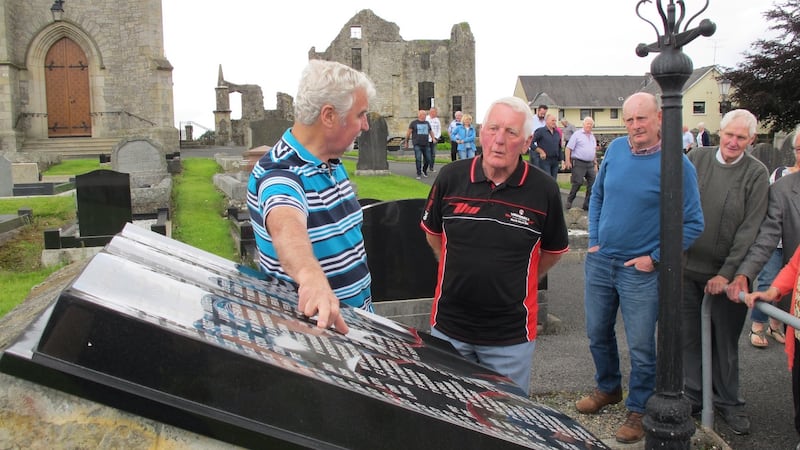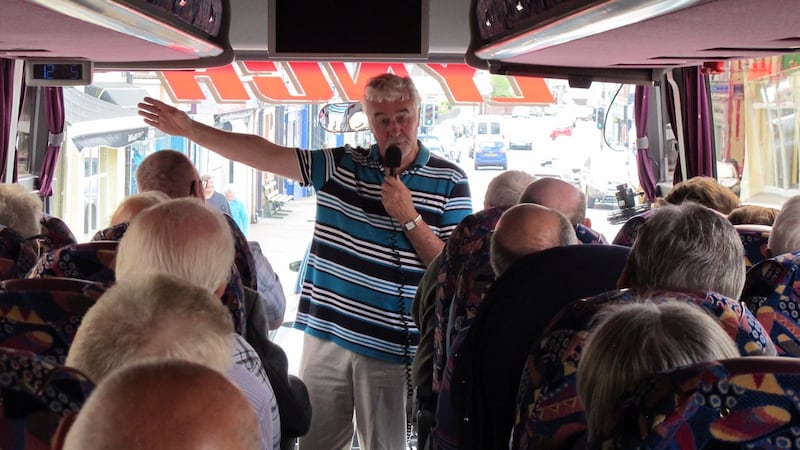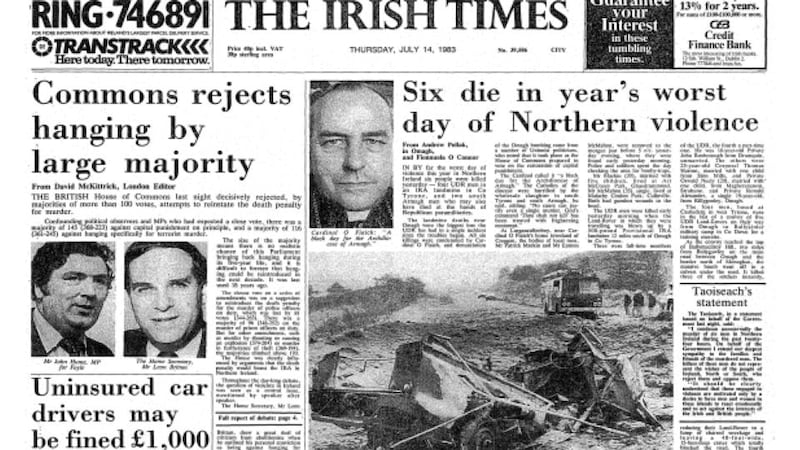As he peered out of the bus window at the spot where the IRA carried out much of its terror campaign in rural Fermanagh, David Temple is reminded of the day he lost his brother William.
The 16-year-old milkman's helper, from Donemana in nearby Co Tyrone, was killed in a triple car bomb attack which ripped the heart out of the rural village of Claudy 40 years ago last week.
"It's still as raw today as it was then," Temple tells The Irish Times.
He is on a bus tour, organised by victims group South East Fermanagh Foundation (SEFF), visiting locations in the Border county where many Protestants were killed during the Troubles.
“It’s very difficult to hear stories of how loved ones were killed along the Border, it’s bringing back memories,” says Temple. “But we can never let go of what happened, it must be told.”

Three car bombs were detonated without warning in Claudy, 11 miles from Derry city, killing five Catholics and four Protestants.
The British Government and the Catholic church were accused of helping to shield Fr James Chesney, a known IRA sympathiser, who was suspected of masterminding the attack.
Temple is joined by more than 40 members of the Castlederg Ulster Defence Regiment Association.
George Harron from Sion Mills is also on the bus. He lost his brother Thomas in 1983. Corporal Harron (24) was from Pollyarnon outside Castlederg, but lived in Sion Mills with his wife and young daughter. He was a piper in Tullywhisker Pipe Band and a member of Tullywhisker "Border Guards".
A couple of miles from the Ballygawley Roundabout, a 600lb culvert bomb was detonated as the vehicle Harron was travelling in drove past – tearing the armoured 4x4 to pieces. A crater 40ft wide and 15ft deep was embedded into the ground. The four occupants of the 4x4 – Harron, Oswell Neely, Ronald Alexander and John Roxborough – died in the attack.
“Being on this bus tour has brought everything back,” says George Harron. “It only takes wee things to strike up the thoughts. As the years go on it’s something you’ll never forget.This tour means a lot, it means people are told things, told the truth.”
Painful
Raymond Monteith from Strabane says being on the bus journey brought back painful memories.
Monteith's brother in law, James Fowler, was shot by the IRA in his chip van in Omagh. He was a driver for the Health and Social Services Board and ran a mobile fish and chip shop. The gunmen flagged the van down, ordered food and as Fowler and his 13-year-old son prepared it they opened fire.
“They were at a housing estate and a man was looking for a bag of chips. Jimmy turned around and the boy fired the pistol and shot him. We had to go to the van to recognise him. I will always have those memories.”
“That’s what a tour like this is important,” says his daughter Diane, who also made the trip. “There are things I’ve never knew about, it’s opened up another avenue for us.”
Across Co Fermanagh at the height of the Troubles, 112 people were killed. In south east Fermanagh, 11 of these people were killed at Lisnaskea, 14 were killed at Rosslea, 13 were killed at Newtownbutler, three in Maguiresbridge and one person in Brookeborough. A total of 29 people were killed in Castlederg by the IRA.

SEFF chairman Eric Brown, who has conducted the Border trail for many years, says the tour aims to pay tribute to the memory of those killed and "open a window on a snapshot of time".
He recalls the murders of Detective Constable Derek Breen and catholic barman John McCabe at the Talk of the Town bar in Maguiresbridge in 1986.
“Derek went to the pub to have a drink, the door burst open and in runs a gunman. He was there to shoot him. Derek was shot, the Catholic barman was also shot. One of the ladies ran outside and shouted they’ve shot poor John McCabe, she didn’t mention Derek had been shot.”
The gunman was described as having worn knee-high brown boots.
Ernie Wilson, a school bus driver and part-time Ulster Defence Regiment (UDR) member, was targeted with an IRA bomb in Lisnaskea while driving 17 teenage girls, including a teenage Arlene Foster, to school in 1988.
Pointing to the bus shelter where the bomb exploded, Brown explains how the driver had almost always checked underneath the bus for suspicious devices before setting off each morning.
“Ernie drove from Maguiresbridge to Lisnaskea and pulled in here. As he was moving off the bomb went off and Ernie was temporally blinded.”
Gillian Latimer, (14), who was sitting beside Foster on the bus, was badly injured.
Walking in a daze
Wilson was later found walking in a daze near the roundabout by his son James. “They’ve blown me up, they’ve blown me up,”, he was heard saying, according to Brown.
“If you plant a bomb on a bus you know what you are doing,” says the former UDR member.
Lisnaskea, less than 10 minutes from the Co Monaghan border, was frequently bombed in the 70s and 80s, while Unionist or Protestant-owned businesses were also regularly targeted.
Shopkeeper Roy Kells, a senior Orangeman, had his clothes shop bombed several times during the Troubles. He was also shot at close range while working on a window display.
“There were five attempts on Roy’s life,” says Brown.
On one occasion, Kells chased the gunman through various premises, but “received no help from locals who said they did not see anything”.
During the Troubles, Lisnaskea binmen, who served part time in the security forces, often carried machine guns, and many times were guarded by police in unmarked cars.
“There was a binman who used to carry a machine gun on his knee, the bin lorry had to be parked at the UDR camp at night,” Brown tells the tour.
Approximately 30 per cent of the town’s population would identify themselves as being from a Protestant or Unionist community and 70 per cent from the nationalist community.
During the 70s and 80s, Lisnaskea, which is minutes from the Border, was bombed at least once a month.
Brown says it was believed that during the Troubles the area’s close proximity to Co Monaghan afforded the IRA ease of access to rural escape routes in the wake of the terror campaign.
The bus tour passes Holy Cross Church in Lisnaskea where two gunmen ran from behind two pillars in 1979 as men sold copies of the An Phoblacht. Opening fire with automatic weapons, they killed two undercover intelligence officers. The deceased were father-of-two Norman Prue (29), a Protestant RUC officer, and Robert Maughan (30), a British Army soldier.
The gunmen made their escape over the Border.
Roadside bomb
Missionary Sylvia Crowe was killed in a roadside bomb, explains Brown, on the main road between Rosslea and Lisnaskea.
The 31-year-old was killed by a remote-controlled trailer bomb explosion on July 17th, 1979. She was standing waiting for a bus, in what appeared to be the middle of nowhere, surrounded by acres and acres of green fields, when she was killed. The IRA had planted a bomb hidden in a low agricultural trailer parked on the roadside.
“Sylvia died instantly, and nobody was ever brought to book,” says Brown. “The IRA didn’t care two hoots about civilian casualties.”

Grant Weir, a Private in the Ulster Defence Regiment, then 22, was seriously injured in the attack.
There are more than 500 people registered as living in Rosslea, with around 97.5 per cent thought to be from a Catholic background and 2 per cent from a Protestant background.
High up on a telegraph pole in the Rosslea area there is a small painted green metal Celtic-cross memorial to IRA volunteer Séamus McElwaine.
Back in April 26th, 1986, McElwaine (25) was ambushed and shot by undercover British Army SAS while approaching an abandoned land mine. McElwaine, from Co Monaghan, operated in the Fermanagh Border areas.
The army had been on patrol in the area and a young soldier saw a command wire beer kegs stacked into a culvert. The officer sent a radio message and the SAS were called. At 5am, two gunmen appeared and were challenged. McElwaine was shot dead and Seán Lynch, his accomplice, was shot and wounded.
“Lynch was badly injured,” says Brown. “He crawled into a drain, covered himself in foliage and it took a dog quite a while to find him. Every year there’s a memorial to McElwaine, but he was a cold-blooded killer.”
Also in this Border area is the Nelson household which was located close to a permanent checkpoint.
Margaret and William Nelson’s children were held hostage by the IRA in their Rosslea farmhouse and two of them abducted in a bid to create a human bomb to drive at an army check point.
Watching television
On the evening of September 3rd, 1981, while both parents were out, their five children David, Sharon, Mervyn, Keith and Lynda were in the farmhouse watching television.
“Armed men ran into the house. The youngest of the family, Sharon, was seven. They put a shotgun to her head, one of the children was severely beaten,” says Brown, pointing to the house.
“They took Linda and David half a mile down that lane and they had a trailer packed with explosives and a tractor and they said to the young guy you drive that to the army checkpoint.”
The young boy got on the tractor, gave it a go but realised the ground was too soft and the tractor bogged. The IRA went back across the Border and got a second tractor, but the operation was unsuccessful.
"It was going to be the largest human bomb ever in Northern Ireland. They then released the two children but before they did that they removed their shoes and made them walk back to the house in their bare feet," explains Brown.

He told the tour about the murders of husband and wife Thomas and Emily Bullock from Derrylin near the Cavan border who were shot dead by the IRA at their farmhouse on September 21st, 1972.
“The gunmen opened fire and Emily was killed. There were 10 bullet holes left in the door. They shot her, stepped over her body, and shot Tommy in the chair. The whole thing took seconds.
“She used to tell people if they ever come for Tommy it’ll be over my dead body,” says Brown.
When the bodies were going from the Bullocks house to Enniskillen the two hearses had a police escort. A crowd of people in the street cheered and others outside a fast food outlet, gathered round and cheered, explains Brown.
"An animal rendering plant at Lisburn received a call to come and collect two bullocks to be picked up in Derrylin. The depth of hatred there was for the Bullock family," he adds.
The tour stops at the sight of a fishing line bomb on the Newtownbutler to Lisnaskea road in an area known locally as “the dash”. To members of the security forces, the dash was an area where they were encouraged to drive through quickly to avoid IRA attacks.
Farmer George Little was reversing his vehicle into the area where the silo pit was located when the sun caught the glint of a fishing line. He stopped his vehicle just in time, had he touched the fishing line, which was actually a bomb trip wire, his whole family would have been killed.
“Everything the IRA planned was planned in reverse because of the Border,” explains Brown.
“If they couldn’t plan their escape the operation could not go down. Everything was against the security forces. We had to be lucky all the time, they only had to be lucky once.”













